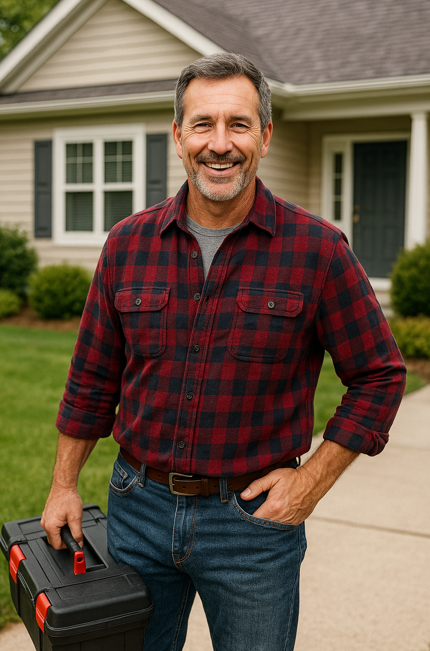👋 Why DIY Maintenance Is a Big Deal
Hey there—Mike Sanders here. If there’s one thing I want homeowners to understand, it’s this:
👉 Your AC won’t take care of itself.
Even the best R-32 air conditioning systems need a little TLC to stay efficient, avoid expensive repairs, and keep you cool all summer long.
This checklist breaks down what you can do monthly, seasonally, and annually—no pro license needed.
🔄 Monthly Must-Dos
✅ Check and Replace Your Air Filter
A dirty filter is like trying to breathe through a pillow. It restricts airflow, wears out your system, and hikes your power bill.
What to do:
-
Check the filter every month (especially in cooling season)
-
Replace every 1–3 months
-
Use MERV 8–13 filters unless your manual says otherwise
📝 Tip: Write the replacement date on the filter frame so you always know.
✅ Inspect the Outdoor Unit
Your AC's outdoor unit (the condenser) needs at least 2 feet of breathing room.
What to do:
-
Turn off power at the disconnect box
-
Remove leaves, grass clippings, or debris
-
Rinse coils gently with a garden hose (avoid pressure washers)
Keep nearby shrubs trimmed and mulch clear. It helps airflow and extends life.
🍂 Spring Startup Checklist
Spring is the perfect time to wake your system up before the real heat hits.
✅ Check Coil Fins and Refrigerant Lines
-
Inspect fins for bending or corrosion
-
Use a fin comb to straighten delicate metal
-
Make sure refrigerant suction lines are insulated and intact
Bent fins reduce airflow. Missing insulation means energy waste.
✅ Reset Your Thermostat
If you’re using a smart or programmable thermostat, switch it back to cooling mode.
🏠 Recommended setting: 78°F when home, 85°F when away
This keeps you cool while saving up to 10% on annual cooling bills.
✅ Give It a Test Run
Run the AC for 10–15 minutes to make sure it’s behaving:
-
Cold air coming from vents
-
No weird noises
-
Compressor and fan running smoothly
If you notice anything off—better to catch it now than during a heatwave.
☀️ Mid-Season Checks
July and August are prime AC stress season. These two habits will help you dodge service calls:
✅ Flush the Condensate Drain Line
Humidity = condensation. Condensate = algae and gunk. And that = overflows.
Once every 2 months:
-
Mix 1 cup vinegar with 1 cup warm water
-
Pour into your drain line or pan
-
Flush with clean water
This simple step prevents mold, mildew, and surprise leaks.
✅ Listen and Look for Trouble
🔊 Strange noises?
-
Grinding = motor trouble
-
Buzzing = electrical issue
-
Hissing = refrigerant leak
Also check for:
-
Ice on the evaporator coil
-
Warm air from vents
-
Short cycling
If you see or hear something strange, shut it down and call a pro.
🍁 Fall Shutdown Tips
When the temps drop, your AC deserves a rest.
✅ Power Off the Outdoor Unit
Flip the disconnect switch or breaker. This prevents accidental startups during unseasonably warm fall days.
✅ Optional: Cover the Unit
Use a breathable AC cover to shield it from falling leaves and snow.
❗ Don’t use plastic tarps—they trap moisture and cause rust. Stick with a mesh cover or skip it if you live in a dry climate.
🧼 Annual Deep Clean & Inspection
Once a year—ideally in spring—you should go a bit deeper:
✅ Clean Coils
Dirty coils reduce heat transfer, making your system work harder (and cost more to run).
DIY Option:
-
Shut off power
-
Use a coil cleaner spray rated for aluminum
-
Rinse gently after foam lifts the grime
💡 The Department of Energy ranks coil cleaning as a top way to improve AC performance.
✅ Check Refrigerant Levels (Safely)
R-32 systems are high-efficiency and eco-conscious, but still need proper charge.
If You’re Not EPA-Certified: Don’t DIY refrigerant work. Instead, watch for cooling performance dips
-
Schedule an HVAC tech if you suspect leaks or warm air issues
Learn more about refrigerant safety from the EPA SNAP Program and ACCA.
⚠️ R-32 Safety: What Homeowners Should Know
R-32 is classified as A2L—mildly flammable. It's totally safe in your system, but you should:
-
Never puncture lines or open valves yourself
-
Avoid open flames near outdoor units
-
Only let licensed pros service refrigerant lines
For best practices, check out ASHRAE’s A2L safety resources.
🧰 When to Call in a Pro
✅ Call a certified HVAC tech for:
-
Spring/fall tune-ups
-
Blower motor issues
-
Electrical or refrigerant problems
-
Diagnosing poor airflow or uneven cooling
🧭 Not sure who to trust? Use the BPI Certified Contractor Directory to find someone qualified in your area.
🔚 Final Thoughts from Mike
Look, I’ve been doing this a long time—and here’s the truth:
🛠️ A little maintenance goes a long way.
If you keep up with these simple tasks, your R-32 AC will:
-
Last longer
-
Run quieter
-
Cool more efficiently
And isn’t that the point?
So grab your checklist, pop the panel on that outdoor unit, and give your system the care it deserves. And if you’re not sure what system is right for your home, check out the R-32 AC guide —I’ve got your back.
🧰Stay smart, stay comfortable, and I’ll catch you next time! - Mike🧰







